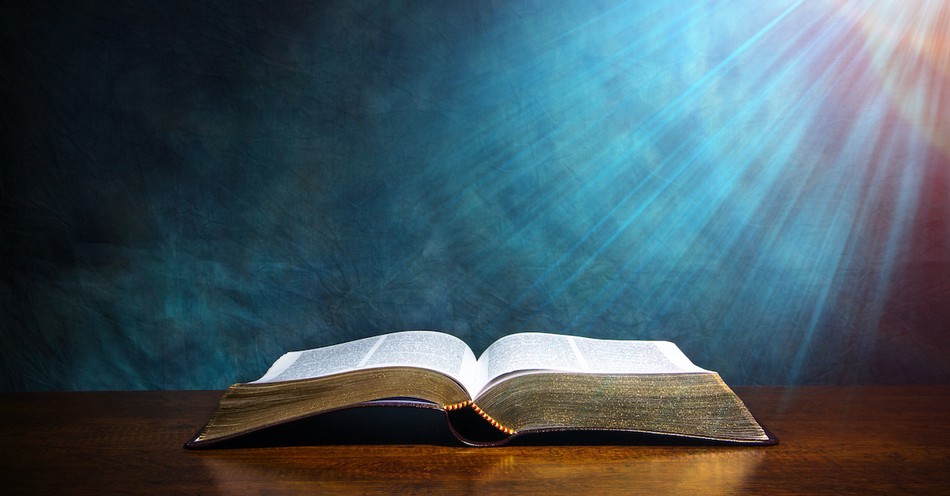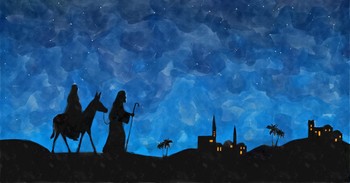"Make the ephod of gold, and of blue, purple and scarlet yarn, and of finely twisted linen—the work of skilled hands." (Exodus 28:6)
Ephod is a word you don’t typically see today, yet it carries great weight in the Bible when it comes to ceremony and honor. The ephod (pronounced "eh-faad") was a part of the garments for the Priests in the Old Testament, with detailed biblical instructions on how it should be made and worn.
King David wore a linen ephod when he famously danced before the Lord when they carried the ark of God from the house of Obed-Edom to the City of David. Moses’s brother, Aaron, donned the ephod and other priestly garments as his formal clothing at the holy Tabernacle, which was the portable sanctuary used by the Israelites to worship the Lord during their years in the wilderness. The prophet Samuel, too, wore an ephod during his service to God.
But what is an ephod, exactly? Is it an article of clothing or a piece of jewelry? And why was it important? Here, we explore the biblical meaning and spiritual significance of the ephod.
The Ephod in Exodus
“Make the ephod of gold, and of blue, purple and scarlet yarn, and of finely twisted linen—the work of skilled hands. It is to have two shoulder pieces attached to two of its corners, so it can be fastened. Its skillfully woven waistband is to be like it—of one piece with the ephod and made with gold, and with blue, purple and scarlet yarn, and with finely twisted linen.
“Take two onyx stones and engrave on them the names of the sons of Israel in the order of their birth—six names on one stone and the remaining six on the other. Engrave the names of the sons of Israel on the two stones the way a gem cutter engraves a seal. Then mount the stones in gold filigree settings and fasten them on the shoulder pieces of the ephod as memorial stones for the sons of Israel. Aaron is to bear the names on his shoulders as a memorial before the LORD. Make gold filigree settings and two braided chains of pure gold, like a rope, and attach the chains to the settings." (Exodus 28:6-14 NIV)
What Does 'Ephod' Mean in the Old Testament?
There are two basic meanings for the word ephod. The most well-known understanding of it is that a garment or item to be worn comes in Exodus and Leviticus, where God describes to Moses exactly what preparations Aaron is to take for his priestly service, including how to wash himself and what to wear. Here, the ephod is included among a litany of sacred garments Aaron is to wear. The other items are a breast piece, robe, woven tunic, turban, and sash (Exodus 28:4). Great detail goes into the Lord’s description of the ephod.
As He specifies, the Ephod should be made: “of gold, and of blue, purple and scarlet yarn, and of finely twisted linen—the work of skilled hands. It is to have two shoulder pieces attached to two of its corners, so it can be fastened. Its skillfully woven waistband is to be like it—of one piece with the ephod and made with gold, and with blue, purple and scarlet yarn, and with finely twisted linen” (Exodus 28:6-8 NIV).
Further, two onyx stones were mounted in gold and fastened on the ephod’s shoulder pieces. These stones are to be engraved with the names of the 12 tribes of Israel, with six names on one and six on the other, and two braided gold chains to connect the stones (v. 9-14).
The ephod was of great importance. It was listed first of these priestly garments, and the breastpiece was to be fashioned after the ephod and tied to it with a blue cord. The crafting of these priestly garments, along with other preparations for the elaborate details of the Lord’s tabernacle, takes up several chapters in Exodus—first, the descriptions of how they are to be made, then the description of the crafting itself. In Exodus 39, we read how the Israelites were obedient in this and crafted the ephod exactly as God commanded.
Shortly after, in Leviticus 8, we read how Moses adorned Aaron with the priestly garments, fastening them all on him. Thus, Aaron and his sons were ordained as God’s priests in accordance with all God’s commands. But the ephod is not just mentioned in Exodus and Leviticus. Years later, the prophet Samuel, who so pleased God, especially in comparison to the showy, sinful sons of the prophet Eli, is described as wearing a “linen ephod” as he served the Lord as a boy (1 Samuel 2:18). We also see King David wearing a linen ephod in 2 Samuel 6:14 and 1 Chronicles 15:27 as he and others carried the ark of the covenant into Jerusalem.
The other meaning of “ephod” is somewhat similar—described less as a garment but rather more as an item of ceremonial, sacred significance, much like an idol or other special item to be worn but not necessarily an item of clothing. This ephod might have been worn or set upon an altar. For instance, in Judges 8:25-27, the Israelites threw gold rings into a pile, which were then melted down and turned into an ephod that Gideon placed in his town, where it was worshipped by the people.
What Was the Spiritual Purpose of the Ephod?
We know the ephod was a tool of ceremony—a special, ornate, handcrafted item with great significance. Much effort went into the making of the ephod, and it was crafted from finery. It carried much symbolic weight. The onyx stones were meant to be memorial stones. We are told in Exodus 28:12, representing the sons of Israel—literally, the descendants of the biblical patriarch Jacob, also known as Israel, through his 12 sons birthed through his two wives, Leah and Rachel, and two concubines, Bilhah and Zilpah. In addition to being a holy item, the ephod is a symbol of the people, as well as their sins. God tells Moses the two stones upon the ephod are, in fact, “memorial stones for the sons of Israel” and that “Aaron is to bear the names on his shoulders as a memorial before the Lord” (Exodus 28:12). They are a part of the ritual the people must do to communicate with God, both to worship God and atone for their sins.
These sons— Reuben, Simeon, Levi, Judah, Dan, Naphtali, Gad, Asher, Issachar, Zebulun, Joseph, and Benjamin—all became the heads of their own family groups, comprising God’s people, Israel. These are the same people who Moses led out of Egypt and into the Promised Land. But the people had gone astray, as the Bible tells us. So God, speaking through Moses, instructed the people on how to live. On Mount Sinai, God commanded Moses to tell the people, “Now if you obey me fully and keep my covenant, then out of all nations you will be my treasured possession. Although the whole earth is mine, you will be for me a kingdom of priests and a holy nation” (Exodus 19:5-6a).
God also told Moses to ensure the people stayed back and did not try to approach the Lord, for they were not holy or capable enough to be in His presence. He told Moses, “Go down and warn the people so they do not force their way through to see the Lord and many of them perish. Even the priests, who approach the Lord, must consecrate themselves, or the Lord will break out against them” (Exodus 19:21-22). God then gave Moses the Ten Commandments and other laws. But when Moses stayed with God too long on the mountain, 40 days and nights, the people turned away from the Lord and worshipped other gods (Exodus 32). God was furious over their disobedience and faithlessness and planned to destroy the Israelites. But Moses pleaded with God to forgive the people, and God relented. He made a covenant with Moses, promising He would still be with the people in spite of their misdeeds as long as they obeyed God (Exodus 34:10-11).
Therefore, the people knew they were duty-bound and bound under threat of annihilation by God Himself to follow God’s commands. They attempted to follow everything God commanded, from His rules about how to make a sacrifice properly and how to build the Tabernacle to who gets to enter the tent and how they are to prepare for this work ceremonially. The ephod was one of these instructions, as significant as the rest. Only the special priest could wear the ephod. It was integral to being ceremonially ready to serve God. Without the ephod—or the breastpiece, tunic, or sash—the priest was unfit to serve. He was not prepared, not “clean” and “holy” enough, to do the work of the Lord. The ephod enabled him to do his job and to hear God properly.
As Moses explained to Aaron, they must follow these directions perfectly or face consequences, including death. “What has been done today was commanded by the Lord to make atonement for you. You must stay at the entrance to the tent of meeting day and night for seven days and do what the Lord requires, so you will not die; for that is what I have been commanded” (Leviticus 8:34-35).
How Did God Speak through the Ephod to His People?
Before Jesus, most people didn’t simply talk with God about His will, whether out of fear they were not holy enough and would incur His wrath or because God typically only spoke through His prophets. So when they wanted to know God’s will, they consulted a priest or prophet, who would then speak to God on their behalf. Those who spoke to God would use holy items, such as the ephod, to help them communicate with the Lord.
For instance, in 1 Samuel 23, when David heard Saul was plotting against him, he went to Abiathar, the priest, and asked him to “bring the ephod” (v. 9). Then David asked God for guidance, and God told him what to do. Later, the same thing happened. David needed guidance from God, so he asked Abiathar again to bring him the ephod (1 Samuel 30:7). David then inquired of God, and God told him what to do.
Much later, the Bible tells us God allowed the destruction of Israel because of their great and continued long streak of disobedience, and that part of their destruction included no guidance from God. As God said through His prophet Hosea, “The Israelites will live many days without king or prince, without sacrifice or sacred stones, without ephod or household gods” (Hosea 3:4). They would be alone, isolated, without help—without God or a way to communicate with Him.
Do We Need an Ephod to Talk to God Today?
We don’t need an ephod to talk to God today, just as we no longer need to sacrifice lambs on the altar to atone for our sins. God sent His Son, Jesus, to be our Savior and “the way and the truth and the life” (John 14:6). Jesus removed the barrier between us and God. We don’t have to fear God’s wrath when we approach Him or think He cannot hear us. Hebrews 4:16 tells us we can “approach God’s throne of grace with confidence, so that we may receive mercy and find grace to help us in our time of need.” And as we’re told in 1 John 5:14, “This is the confidence we have in approaching God: that if we ask anything according to his will, he hears us.”
Jesus is our “high priest,” our Redeemer, and He is all we need.
Photo credit: ©GettyImages/Javier_Art_Photography





